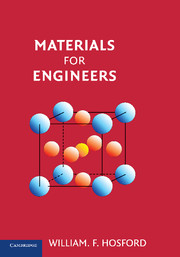Book contents
- Frontmatter
- Contents
- Preface
- 1 Introduction
- 2 Phases
- 3 Diffusion
- 4 Mechanical Behavior
- 5 Mechanical Failure
- 6 Annealing
- 7 Iron and Steel
- 8 Nonferrous Metals
- 9 Casting and Welding
- 10 Solid Shaping
- 11 Polymers
- 12 Polymer Processing
- 13 Glasses
- 14 Crystalline Ceramics
- 15 Powder Processing
- 16 Pottery and Concrete
- 17 Composites
- 18 Carbon
- 19 Fibers, Foams, and Porous Materials
- 20 Electrical Properties
- 21 Optical and Thermal Properties
- 22 Magnetic Materials
- 23 Corrosion
- 24 Modern Manufacturing Techniques, Surface Treatments, and Recycling
- APPENDIX 1 Wood
- APPENDIX 2 Miller Indices for Planes and Directions
- APPENDIX 3 X-ray Diffraction
- APPENDIX 4 Surfaces
- APPENDIX 5 Dislocations
- APPENDIX 6 Avrami Kinetics
- APPENDIX 7 Organic Chemistry
- APPENDIX 8 Average Molecular Weight
- APPENDIX 9 Bond Geometry in Compounds
- APPENDIX 10 Weibull Analysis
- Index
- Conversions
APPENDIX 5 - Dislocations
Published online by Cambridge University Press: 05 June 2012
- Frontmatter
- Contents
- Preface
- 1 Introduction
- 2 Phases
- 3 Diffusion
- 4 Mechanical Behavior
- 5 Mechanical Failure
- 6 Annealing
- 7 Iron and Steel
- 8 Nonferrous Metals
- 9 Casting and Welding
- 10 Solid Shaping
- 11 Polymers
- 12 Polymer Processing
- 13 Glasses
- 14 Crystalline Ceramics
- 15 Powder Processing
- 16 Pottery and Concrete
- 17 Composites
- 18 Carbon
- 19 Fibers, Foams, and Porous Materials
- 20 Electrical Properties
- 21 Optical and Thermal Properties
- 22 Magnetic Materials
- 23 Corrosion
- 24 Modern Manufacturing Techniques, Surface Treatments, and Recycling
- APPENDIX 1 Wood
- APPENDIX 2 Miller Indices for Planes and Directions
- APPENDIX 3 X-ray Diffraction
- APPENDIX 4 Surfaces
- APPENDIX 5 Dislocations
- APPENDIX 6 Avrami Kinetics
- APPENDIX 7 Organic Chemistry
- APPENDIX 8 Average Molecular Weight
- APPENDIX 9 Bond Geometry in Compounds
- APPENDIX 10 Weibull Analysis
- Index
- Conversions
Summary
Edge and Screw Dislocations
Plastic deformation of crystalline solids occurs primarily by slip, which is the sliding of atomic planes over one another. An entire plane does not slide over another at one time. Rather it occurs by the motion of imperfections called dislocations. Dislocations are line imperfections in a crystal. The lattice around a dislocation is distorted so the atoms are displaced from their normal lattice sites. The lattice distortion is greatest near a dislocation and decreases with distance from it. One special form of a dislocation is an edge dislocation that is sketched in Figure A5.1. The geometry of an edge dislocation can be visualized by cutting into a perfect crystal and then inserting an extra half-plane of atoms. The dislocation is the bottom edge of this extra half-plane. An alternative way of visualizing dislocations is illustrated in Figure A5.2.
An edge dislocation is created by shearing the top half of the crystal by one atomic distance perpendicular to the end of the cut (Figure A5.3B). This produces an extra half-plane of atoms, the edge of which is the center of the dislocation. The other extreme form of a dislocation is the screw dislocation. This can be visualized by cutting into a perfect crystal and then shearing half of it by one atomic distance in a direction parallel to the end of the cut (Figure A5.3C). The end of the cut is the dislocation.
- Type
- Chapter
- Information
- Materials for Engineers , pp. 254 - 257Publisher: Cambridge University PressPrint publication year: 2008



